
No ka Mahina ʻŌlelo Hawaiʻi o kēia makahiki, ua hui nō mākou me Mana Maoli a me Mana Mele no kekahi papahana hou, ʻo ia hoʻi he mau wikiō leo ʻelua no ka moʻolelo Hawaiʻi i kapa ʻia ʻo Nanea Wainohia. He ʻōlelo kēia na kekahi o nā mea kākau o mua e hōʻike mai ana nō, he mea ka moʻolelo e hialaʻai ai ka noʻonoʻo o ke kanaka ke noho nanea nō ʻo ia i ka heluhelu.
This year we decided to celebrate Mahina ʻŌlelo Hawaiʻi by teaming up with Mana Maoli & Mana Mele to bring you a series of four bilingual conversations on moʻolelo Hawaiʻi called Nanea Wainohia. This name refers to the pleasurable and relaxing pastime of reading and was a term authors used to refer to the stories they were writing down and giving over to newspapers to be published.
Ua lilo ʻo Nanea Wainohia he wā e walea ai i ke kamaʻilio me nā laeʻula ʻōlelo Hawaiʻi a lohe i ko lākou mau manaʻo no nā moʻolelo a lākou e mahalo piha ai, nā mea hoʻi e hānai ana i ko lākou noʻonoʻo a e hoʻoulu ana i ko lākou manaʻo. Ma o ko lākou aloha i ka moʻolelo kākou e ʻike ai ē, he pūnāwai nō ia e inu ai kākou a kena, e ola ai hoʻi a ola loa.
Nanea Wainohia was an opportunity for us to hear from folks who have been in ʻōlelo Hawaiʻi for years about the moʻolelo that inspire and nourish them. Their fire for these stories and their insights into the ʻike in them demonstrate why we should all be having more moʻolelo in our lives.
E nanea ʻoukou i ka nānā a me ka heluhelu!!!
A special mahalo goes out to our collaborators for this series:

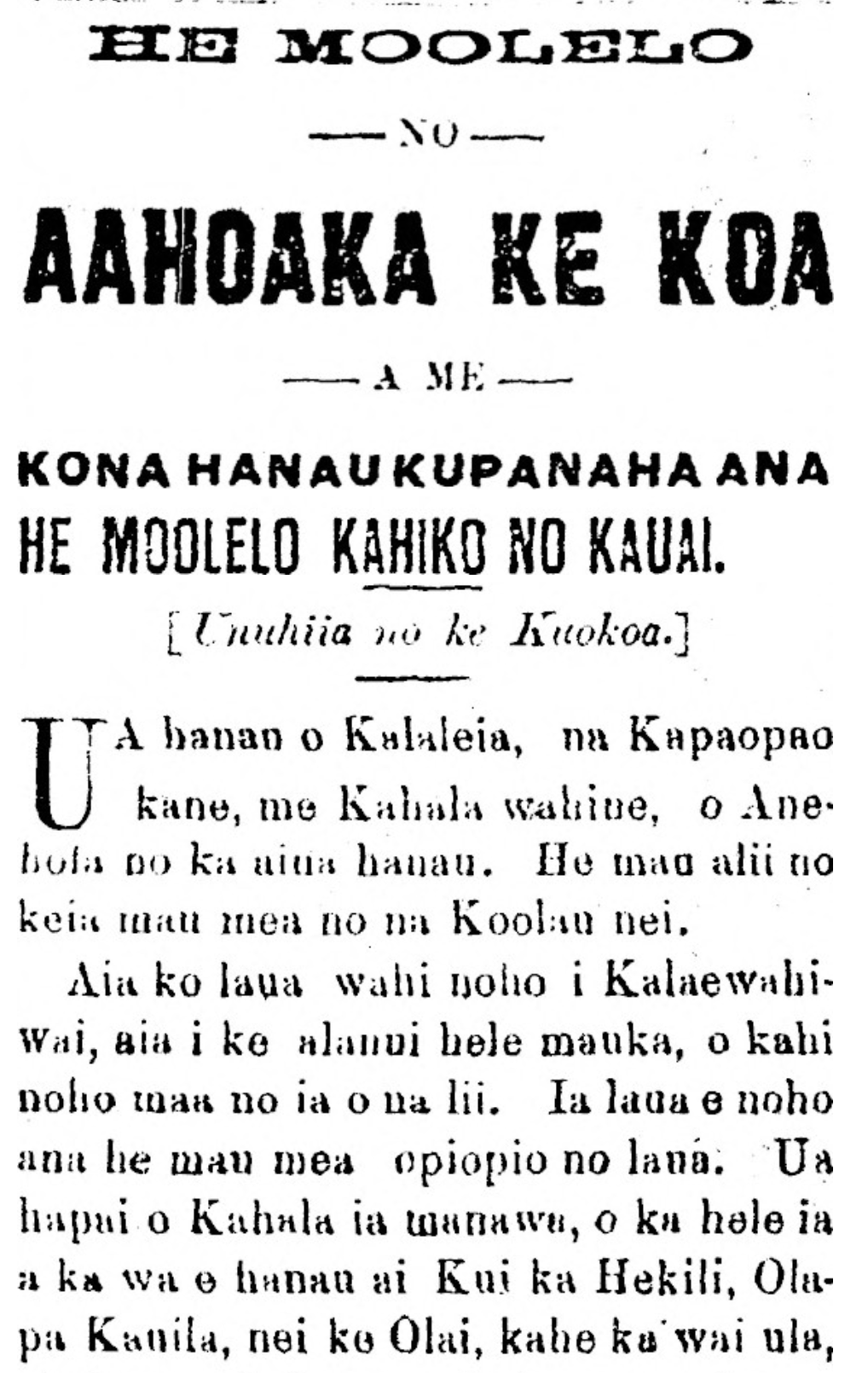
ʻAʻAHOAKA
me ʻAlohilani Rogers
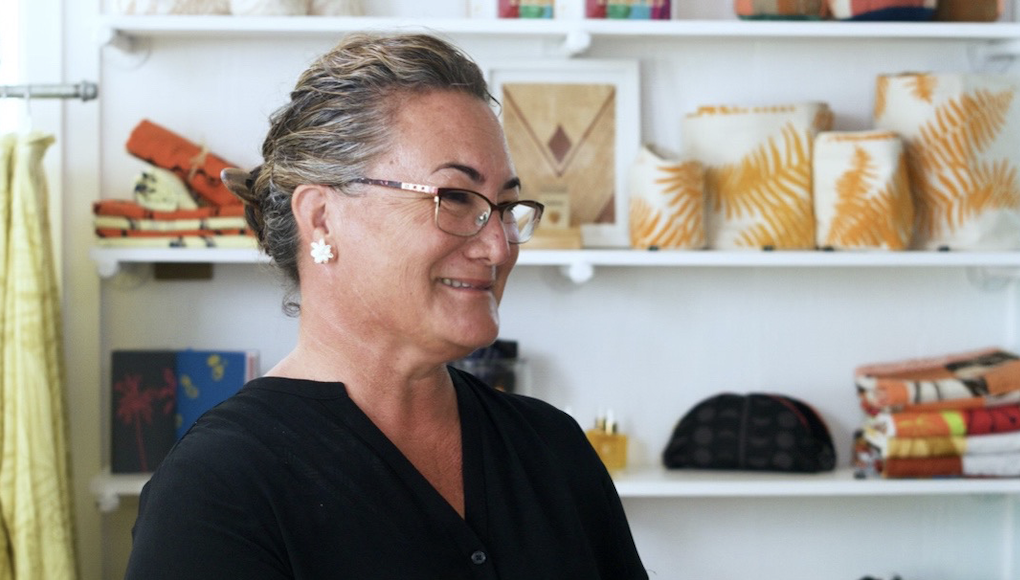
He 30 makahiki ka lōʻihi o ko ʻAlohilani hana ʻana ma ke Kula Kaiapuni a mau nō kona aloha i ke aʻo. Ua lilo nō kēia moʻolelo i mea nui nona a no kāna poʻe haumāna. He ala ia e ola hou ai ka ʻike no ko lākou mokupuni aloha, ʻo ia hoʻi ʻo Kauaʻi.
ʻAlohilani Rogers has worked within Kula Kaiapuni for 30 years and still loves teaching and learning. This story has become a focal point for curriculum and a beautiful opportunity for and her students to recover knowledge about their beautiful island, Kauaʻi.

ʻO ka mea e kū kahi ai kēia moʻolelo kahiko no Kauaʻi, ʻo ia hoʻi ka nui o ka ʻike o loko no ke aliʻi wahine hāpai: kona mau ʻono, ka hoʻokō ʻia ʻana, a me nā lāʻau lapaʻau e pono ai ke pilikia ma ka hānau keiki ʻana.
This traditional tale from Kauaʻi is unique in its focus on aliʻi wahine who are pregnant: what they crave, how that ʻono is fulfilled, and plant medicines given when they have trouble in labor.
ʻAʻole maopopo ka mea nāna kēia moʻolelo i kākau a me ka lōʻihi maoli hoʻi ʻoiai ua "pau honua" wale nō, e like me ka ʻōlelo a ʻAlohilani. ʻO nā helu naʻe i loaʻa, ua piha i nā inoa ʻāina a me ka ʻike no ka lāʻau lapaʻau pili hānau keiki. He hōʻike nō hoʻi ia i ka nohona a me nā pilina o nā aliʻi o Kauaʻi.
We do not know who authored this story or how long it really is because it cuts off after the 9th instalment. What it offers in those first nine helu, however, is a rich abundance of place names, a wealth of knowledge about birth medicine, and an illustration of lifestyle and relationships among the aliʻi of Kauaʻi.
Nā Helu a pau o ka moʻolelo:
Helu 1
Helu 2
Helu 3
Helu 4
Helu 5
Helu 6
Helu 7
Helu 8
Helu 9
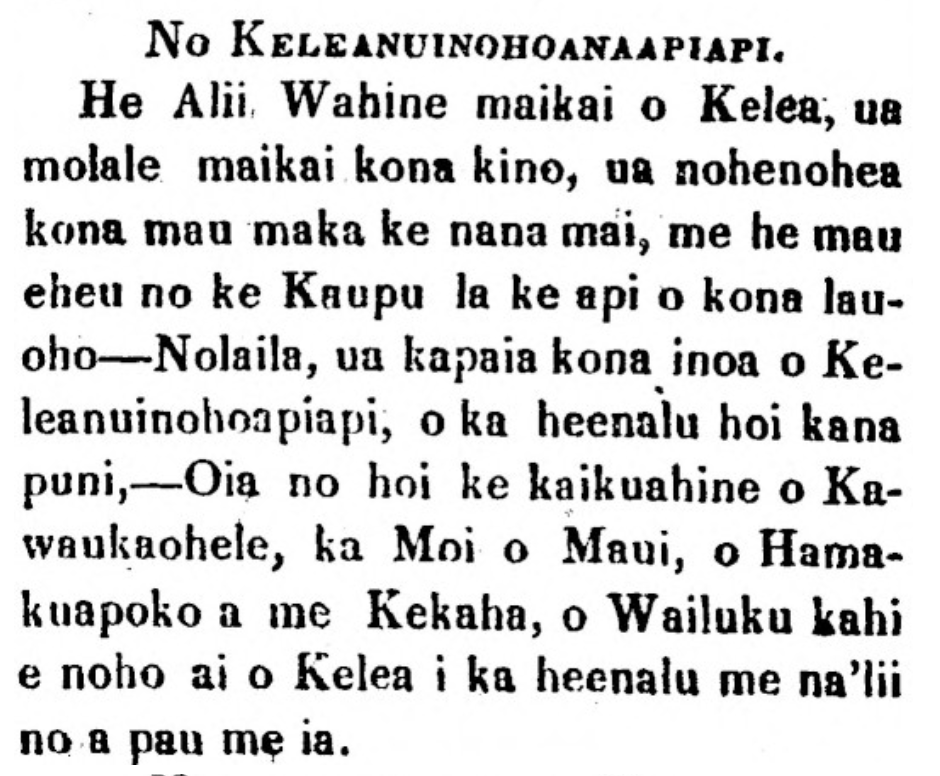
KELEANUINOHOANAʻAPIʻAPI
me Pūlama Collier
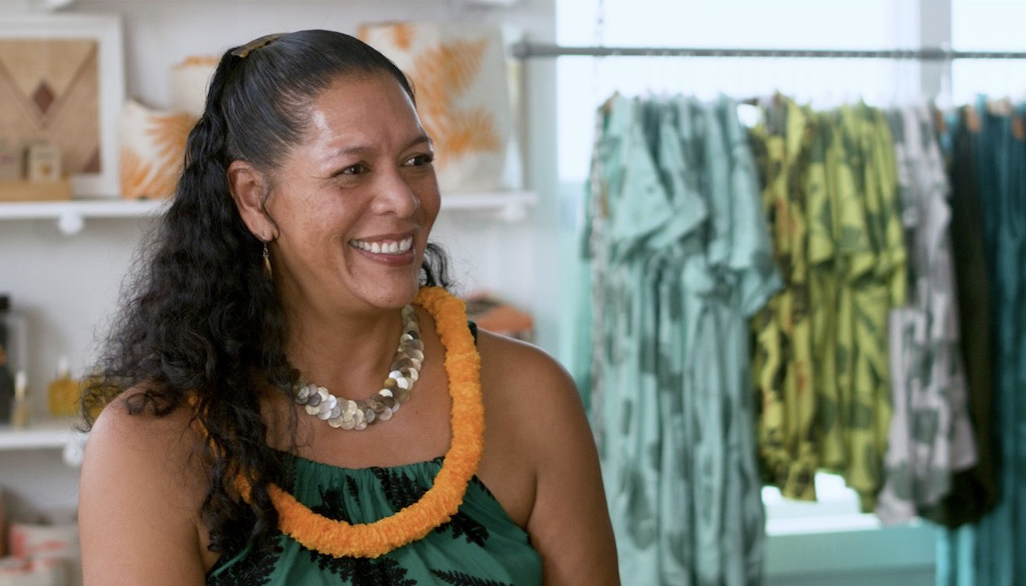
E like nō hoʻi me ka hoa kipa mua o kākou, he kumu kaiapuni ʻo Pūlama nona nā makahiki he 30 a ʻoi o ke aʻo ʻana. Hoʻoikaika mau ʻo ia i ka ʻimi ʻana i nā moʻolelo, mele, oli, a me nā pule e pāhola ai i mua o kāna mau haumāna me ka ʻānoni ʻana nō hoʻi i ia mau ʻike a akamai i loko o nā haʻawina like ʻole o kāna mau papa, he mau mea hoʻi i loaʻa ʻole ma ka hoʻonaʻauao ʻia ʻana o kona hanauna. Nani ka holomua o ka lāhui ma o ka papahana kaiapuni!
Like our first guest, Pūlama is also a kaiapuni teacher of 30 years. She is constantly working to bring the brilliance of our kūpuna into the curriculum through the use of stories, songs, chants, and prayers. She weaves these into her teaching approach for all her classes, enriching her haumāna with ʻike Hawaiʻi, ʻike that was not taught in school when she was a student. So many strides have been made for the lāhui through Hawaiian-language immersion education.
ʻO kahi mea nani no kēia moʻolelo, ua loaʻa nō i ua Pūlama nei i loko o kona noiʻi ʻana i ka moʻokūʻauhau. ʻIke akula ʻo ia, he mamo nō na Piʻilani a ma ka hoʻokolo ʻana, ua ʻike ʻia kona pilina i kēia kāʻeʻaʻeʻa heʻe nalu i kaulana i ka uʻi a me ke oʻoleʻa, ʻo ia hoʻi ʻo Keleanuinohoanaʻapiʻapi.
Pūlama's personal connections to this moʻolelo are fascinating in that she found it while doing genealogical research. She discovered she was a descendant of Piʻilani which led her to finding her connection to this expert surfer who was famous for being both beautiful and strong, Keleanuinohoanaʻapiʻapi.

He māhele kēia moʻolelo no kā Kamakau mau moʻolelo i kākau ai i ka makahiki 1865. "Hoʻomākaʻikaʻi" ʻo ia i ka poʻe ma ka paeʻāina me ka haʻi moʻolelo no nā wahi like ʻole. Ke hiki aku ʻo ia i Waikīkī, puka mai kēia moʻolelo no ke aliʻi wahine heʻenalu o Maui i "lilo" i ka waʻa ʻimi wahine no kekahi aliʻi o Oʻahu, ʻo Lo Lale hoʻi. Lilo auaneʻi ʻo ia i wahine nā ia aliʻi akā no ka pakuā o ka nohona o uka, haʻalele ʻo ia nei ia ia ala, hoʻi aku nō i kai a lilo i wahine na ka hoʻokele o ka waʻa nāna ʻo ia i kiʻi, ʻo Kalamakua. He moʻolelo nui kēia no ka moʻokūʻauhau o nā aliʻi o Maui, Oʻahu a me Hawaiʻi.
This story is a part of Kamakau's wrtings from 1865. He takes his readers on a tour of the islands, telling stories about various places. When he reaches Waikīkī, this story emerges about a surfing chiefess who was "taken" by a canoe on a mission to find a wife for Oʻahu chief Lo Lale. She becomes his wife, but grows tiresome with life in the uplands. On her journey home, she reaches the ocean and reconnects with Kalamakua the steersman of the canoe that originally brought her to Oʻahu. This story has lots of important genealogical information about the chiefs of Maui, Oʻahu and Hawaiʻi.
Nā Helu a pau o ka Moʻolelo:
Helu 1
Helu 2
Aia kekahi mana o kēia moʻolelo ma ka puke a ka Mōʻī Kalākaua. He nui nā hunahuna ʻike ʻono āna e hoʻolako ai ma ka ʻōlelo haole a makepono nō ka heluhelu ʻana!
Another version of this moʻolelo can be found in Kalākaua's book. He gives rich detail in his English version, which is definitely worth a read!
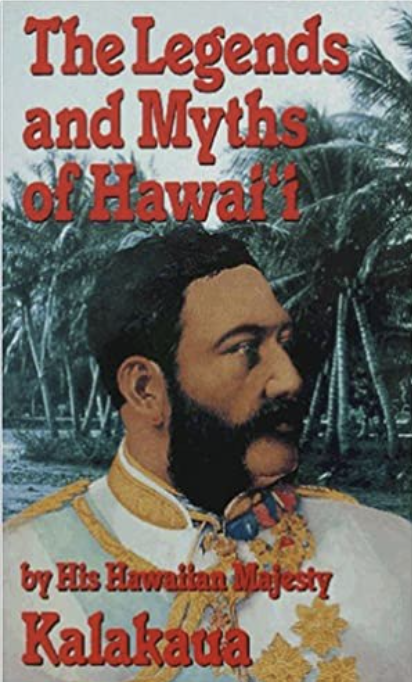
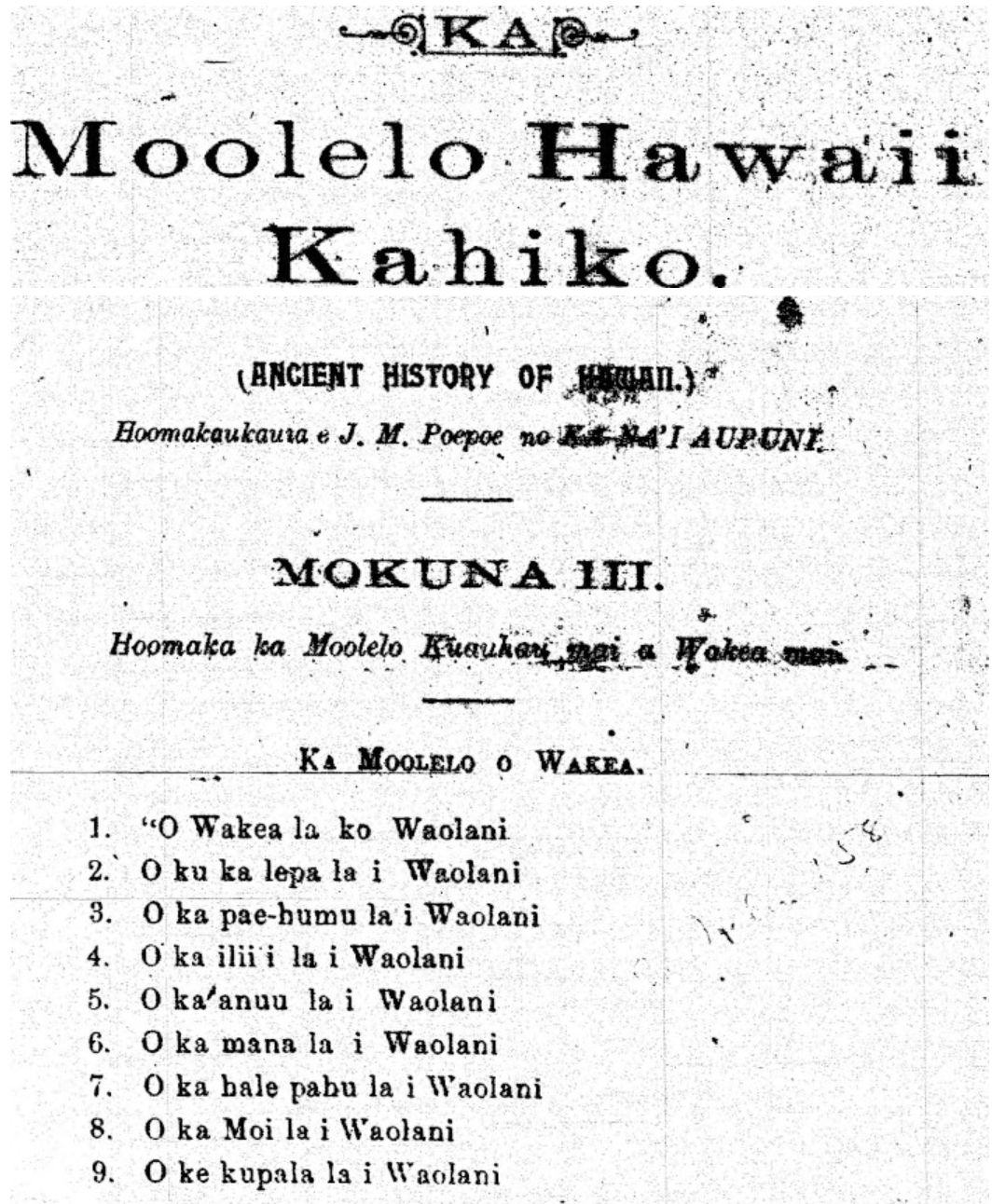
NO KO WĀKEA MĀ NOHO ʻANA MA KALIHI, KA LOAʻA ʻANA O KE AKUA ʻULU ʻO KĀMEHAʻIKANA
me Kamuela Yim
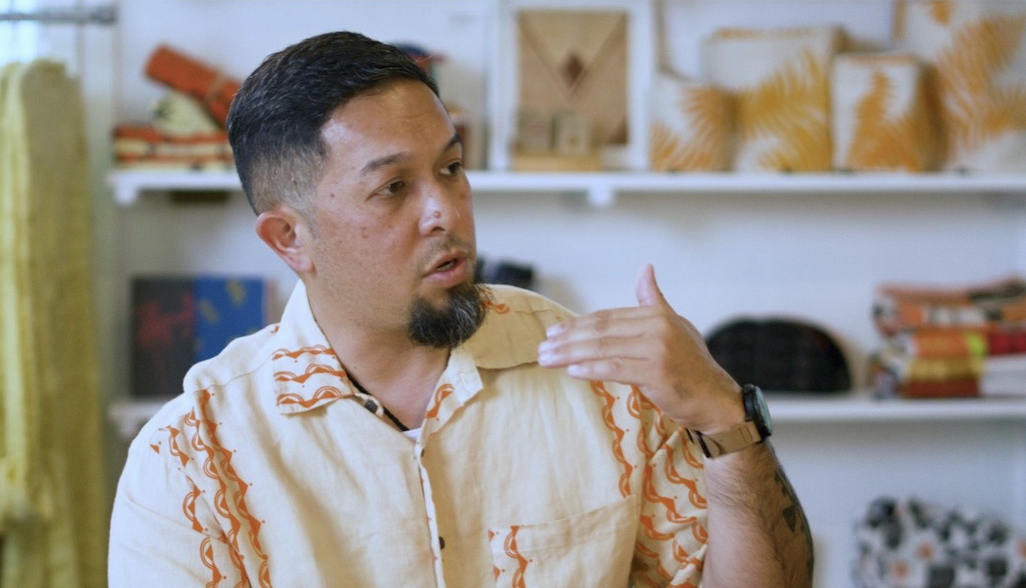
I loko o kona mau makahiki he 25 o ka hele ʻana ma ke ala ʻōlelo Hawaiʻi, ua nui nā hana like ʻole a Kamuela Yim ma nā māhele like ʻole o ka ʻōlelo Hawaiʻi. Na ka hana unuhi ʻōlelo paha i paipai i kona kālailai nui ʻana i nā haʻawina o nā moʻolelo kupuna, kahi mea āna e noʻonoʻo nui ai a e ʻimi ai hoʻi i kona mau pilina i ka nohona o kēia wā.
In his 25 years of walking the path of Hawaiian language, Kamuela Yim has experienced several facets of language work. Translation may be the one that has pushed him to think critically about traditional stories and find the lessons in them that can apply to our lives today.
Koho akula ʻo ia i ka moʻolelo i hōʻike ʻia aʻela i luna, ka mea a kākou e kapakapa aku ai ʻo Kāmehaʻikana. Ua nui ko mākou hauʻoli i kēia koho ona ʻoiai he moʻolelo nui kēia no mākou ma Kealopiko. Na Joseph Mokuʻōhai Poepoe i kākau i kēia moʻolelo a hoʻolaha akula nō ma ka nūpepa Ka Nai Aupuni i ka makahiki 1906. He koʻi ʻula nō kahi Poepoe a e loaʻa aku nō ka ʻike no kāna mau hana a me kona ola ma ka puke The Power of the Steel-tipped Pen na Noenoe Silva.
Kamuela chose the story we call by the nickname Kāmehaʻikana. We were thrilled by this choice, as this story is an important one for us at Kealopiko. It was written and published by Na Joseph Mokuʻōhai Poepoe in the Ka Nai Aupuni newspaper in 1906. Poepoe is an author of great accomplishment and you can learn all about his life and work in the insightful book by Noenoe Silva, The Power of the Steel-tipped Pen.

ʻO ka hoʻomana me ke kālaiʻāina nā kumuhana nui loa o nei moʻolelo ma ke ʻano hoʻi e pili ai i nā hana a Wākea lāua ʻo Haumea. Akā, ʻo ke kuleana ke kahua e kūkulu ʻia ai ia mau mea i ka manaʻo o ko kākou hoa kipa, ʻo Kamuela. Ma ua moʻolelo nei kākou e ʻike ai, ke piʻi aʻe ke kuleana o Wākea lāua me kāna wahine hoʻokalakupua, piʻi pū nō ka mana a me ke kūlana. ʻO ka ʻimi naʻe i ka pono o kānaka ke kumu paha e komo ai lāua i loko o nā hana like ʻole.
Religion and politics are at the heart of this story, specifically as they pertain to Wākea and Haumea's lives and actions. But for our guest on this episode, kuleana is the driving force behind everything Wākea and Haumea do. We see through this story that as their kuleana increases, so does their mana and their station. Their primary objective, however, is the good of the people.
Ka helu mua o ka moʻolelo:
Helu 1
No ka nui o nā helu o nei moʻolelo, aia iā ʻoukou, e nā hoa, ka hoʻokele ʻana i kou waʻa heluhelu mai kekahi helu a i kekahi.
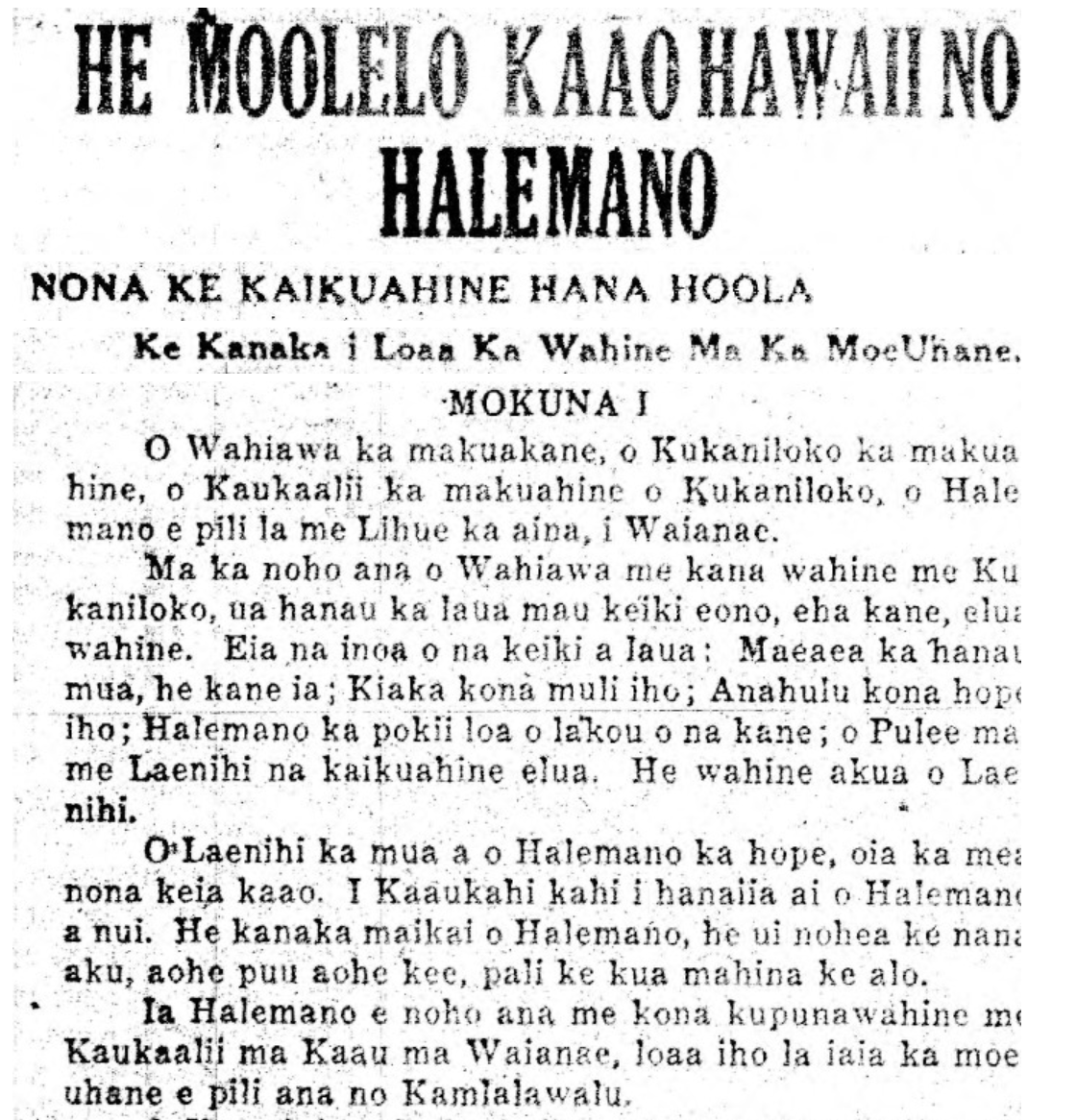
HALEMANO
me Mānaiakalani Kalua
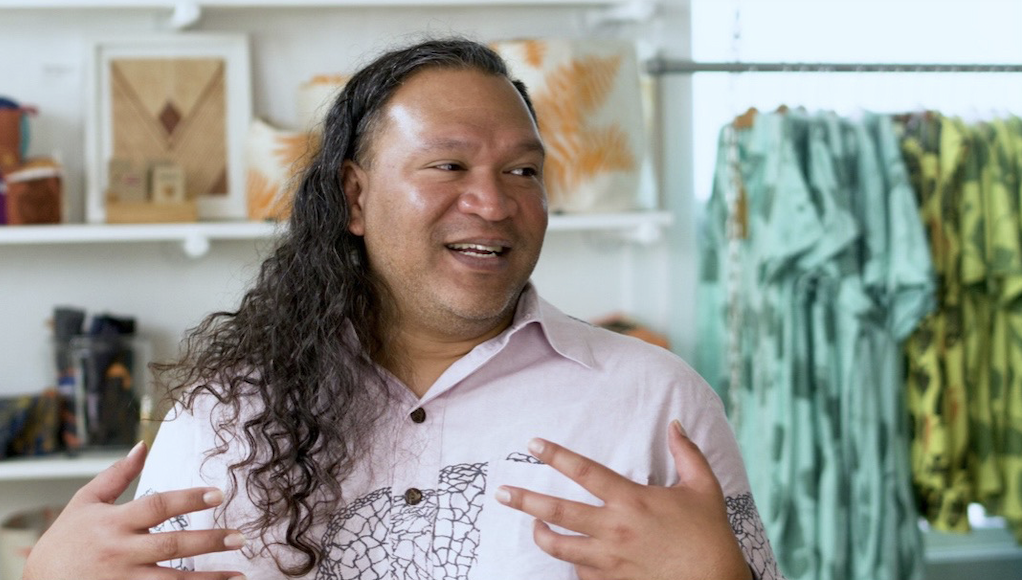
He mea oli, he mea hula, a he kumu nō hoʻi ʻo Mānaiakalani Kalua, a no ia mau nea nō, he ʻike nui a lāulā kona i nā moʻolelo me nā mele. Pēlā nō i ulu aʻe ai ka mahalo i loko ona no kēia moʻolelo piha i nā mele nani, ʻo ia hoʻi He Moʻolelo Kaʻao Hawaiʻi no Halemano.
As a chanter, dancer, and teacher, Mānaiakalani Kalua has a deep and vast knowledge of story and song. It is this path of working with ʻike Hawaiʻi that has given him a true appreciation for this story that is rich in poetry, He Moʻolelo Kaʻao Hawaiʻi no Halemano.
He mau haʻawina koʻikoʻi nō hoʻi ko kēia moʻolelo no ke aloha a me nā pilina kanaka. A no ia mea, hāpai aʻe ʻo Mānai i ua moʻolelo nei i loko o kāna papa e aʻo ai i nā ʻōpio. Wahi āna, ke heluhelu lākou i ka moʻolelo a laila komo i ke kamaʻilio a me ke kālailai ʻana, he wā nō ia e puka mai ai nā moʻolelo a me nā nīnau i pili ponoʻī i nā haumāna, nā mea hoʻi a lākou e ʻano ʻauʻa ai paha inā nīnau kikoʻī ʻia aku. A ma ia ʻano he mea ka moʻolelo kupuna e pili ai nā mākua a me nā ʻōpio o kēia au.
This story has many significant lessons about love and relationships. Because of that, Mānai uses it in his classes with young people. He says that when they read it and discuss it, stories and questions relating directly to students and their own lives come out - things they would normally keep to themselves if asked directly. In this way, ancestral stories facilitate connection between older and younger generations.

He aliʻi ʻo Halemano no Oʻahu a ma ka moe ʻuhane ʻo ia e launa ai i kahi wahine uʻi. Me ke kōkua pū mai o koa kaikuahine hoʻokalakupua, ʻimi a loaʻa ka wahine iā ia, a lawe wale ʻia aku i Oʻahu, kahi e noho ai. He pilina piha hihia ko lāua a he mea ia e luʻuluʻu ai ʻo Halemano i kahi manawa. Ma o ke aʻo ʻana i ka hula, loli kona ʻano kanaka a loli pū kona makemake ma ka pilina aloha.
Halemano is an Oʻahu chief who meets a beautiful wahine in his dreams. With the help of his shapeshifting sister, he finds her and steals her back to his home. Their relationship is rocky, often drving Halemano into bouts of deep depression. Through learning the art of hula, Halemano undergoes a personal transformation that eventually changes who he is and what he wants from both life and relationships.
He Mau Manaʻo hou aku no ka Moʻolelo
Aia ma kahi o ka 100 nūpepa ʻōlelo Hawaiʻi i paʻi ʻia ma waena o nā makahiki 1834-1950 paha. He waihona ʻike hohonu a laulā nō kēia i piha i nā moʻolelo makamae na nā kūpuna. I loko o nā makahiki 15 iho nei paha, ua hoʻolilo ʻia i mau faila uila a i kēia mau lā, he hiki nō ke kiʻi wale ʻia aku me ka maʻalahi.
With nearly 100 Hawaiian-language newspapers printed over more than a century, our kūpuna left us a deep and vast trove of literary treasures. Massive efforts over the last (roughly) 15 years to digitize and make searchable this huge body of knowledge have have brought it to our fingertips.
ʻO ka moʻolelo kaʻao ka puka e "komo" aku ai kākou i loko o ke ao o nā kūpuna i mea e ʻike ai i nā manaʻo, ʻano, hana, a nohona hoʻi o lākou i ka wā i kū ai ka ʻōlelo Hawaiʻi i ka moku a i ola ai nā hana Hawaiʻi like ʻole.
Moʻolelo kaʻao from that waihona allow us to wind the clock back and peek through windows into the world of our kūpuna, showing us how they thought, acted, and lived life in a time when our language and culture were not in danger or rareified.
Inā ʻo ka niʻo o ka ʻōlelo kāu e kūlia nei, aia nō ia ma nā moʻolelo Hawaiʻi i kākau ʻia i ia wā. Ua hoʻoili ʻia mai, mai kekahi hanauna a i kekahi a laila kākau ʻia iho a hoʻolaha ʻia aku e ka poʻe naʻauao o ia wā. Ma ka pākahi, he mau ʻike e kū hoʻokahi ai kēlā me kēia. Ma ke ʻano huina, kohu hale waihona puke piha i ke akamai a me ka noʻeau o nā mea o mua aku.
If it is the summit of our language that you seek, moʻolelo like these are the gold standard of written Hawaiian. They were handed down through the generations and published by learned folks of the time. Individually they each have unique things to offer. Collectively they form the intellectual library left behind by our fore-bearers.
